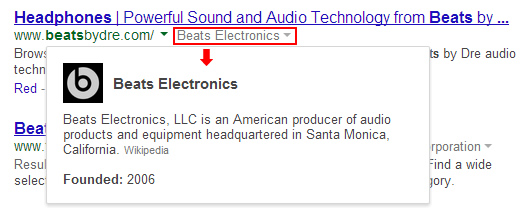
Last Wednesday, Google rolled out new functionality in the search results, which sure got the attention of SEOs across the industry. Now when searching for information, you will sometimes see an additional link directly in the search results for specific organizations and/or websites. Users can click on that link to view additional information about that organization right in the search results (via data from Google’s Knowledge Graph).
Google states that this can occur for websites that are “widely recognized as notable online, when there is enough information to show or when the content may be handy for you.” When clicking the link next to the URL in the search snippet, a small window opens providing the information. It’s basically a hover card that provides additional information. This is an important move by Google, since users don’t need to leave the search results to find more information.
Here’s an example of the info card for Netflix:
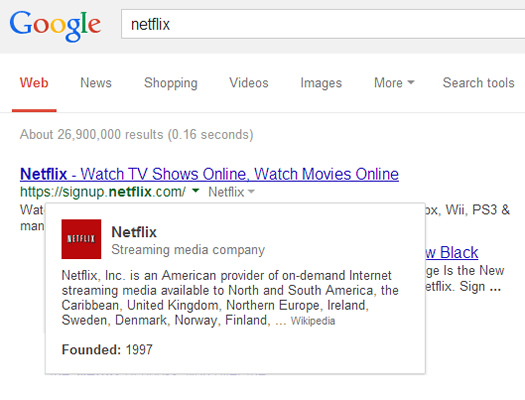
The information displayed in the hover card is based on Google’s Knowledge Graph, or data that Google has collected about “real world things”. Knowledge Graph data comes from a variety of trusted sources, including Freebase (which Google acquired), Wikipedia, CIA World Factbook, etc. As of July of 2012, Google had collected information about 570 million entities, including 18 billion facts and connections.
To quickly summarize the new addition to the search engine results pages (SERPs), if you are searching for answers, and Google has information in its Knowledge Graph about the sites ranking in the search results, you just might see that new link appear directly within the search listing. And if you click that link, you’ll see Knowledge Graph data in a small window directly in the search results.
Hover Creep: Your Content, Answers, Products, and Downloads Directly in the Search Results?
As I was testing these new “Info Cards”, I started to think deeper about what was occurring, and how this might be the next phase of a monumental shift for Google. Over the past few years, SEOs have seen Google provide more and more information directly in the search results. For example, check out all of the types of answers Google will provide right in the results (courtesy of Pete Meyers). Based on this shift to the all-knowing SERP, many SEOs believe that at some point, Google won’t need to drive users to third party websites anymore. Instead, maybe it could provide all the information directly in the results.
Don’t believe me? How about this search for “calories in bananas”:
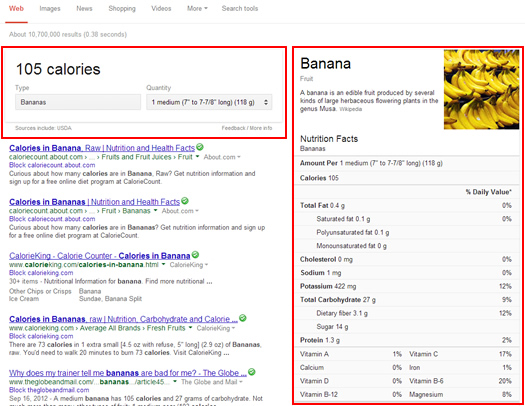
Expanding Hover Cards – Coming Soon to a SERP Near You
Based on how much information Google is already providing in the search results (driven by Knowledge Graph data), combined with new hover card functionality in the search results, is it really far-fetched to think Google could expand this approach? Sure, it won’t happen overnight, but as Google collects and trusts more information from trusted third parties, it could absolutely start providing that data right in the search results.
And that little popup window (hover card) is the first sign that Google isn’t afraid to add more information directly in the SERPs for specific listings. Let’s face it, providing author details (based on authorship markup) is one thing. But using a hover card to provide more content per search listing is another.
And maybe this is just a test to see how users react before rolling out more and more content directly in the search results. And maybe it’s not limited to content… maybe other types of functionality are coming, like ecommerce functionality, downloads, sign-ups, etc. Now that would be interesting, unless of course, you’re the owner of that content, download, etc. who gets cut out of the process. Yes, beware the hover card.
So, let’s have some fun and explore what this could look like and how it could work. It just might be closer than you think.
Trusted Sources, and a Note About Publishership
Some of you reading this post might be wondering how Google could verify typical websites, especially since it’s using trusted data for the recent release of “info cards”. For example, Google trusts the data in its Knowledge Graph, so it’s comfortable providing the popup window with more information about certain entities. But will it do this for the average site on the web? If Google is going to provide more information directly in the search results, then it’s going to have to trust those third party websites, and their content, to do so.
Although many website owners have been focused on authorship markup, where author details can show up in the search results, there is publishership as well. By claiming publishership (rel=publisher), Google can connect a website to an entity in Google Plus (similar to the way an author is tied to a G+ profile). That connection could possibly be the basis for providing more content in the search results. And yes, this could drive even more people to Google+ over the next few years.
By the way, just last year Google tested out showing publisher images in the search results (similar to author details). I saw the test live, and others did too. I almost fell out of my seat when I saw client logos in the search results. That test was removed quickly once word started getting out, but here’s a screenshot of what that looked like. Check out the publisher image in the search results below:
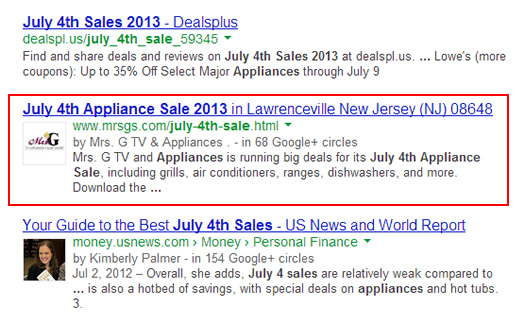
So, if Google understands more about a website via publishership, maybe it can use data from the website to provide more information directly in the SERPs. Hey, it’s entirely possible.
Now, if this was the case, at least website owners could remove publishership from their sites (if they didn’t like Google providing more data directly in the search results). But that could be a double-edged sword for content owners. Sure, you could stop Google from providing your answers in the search results, but maybe Google won’t rank your listings highly anymore (since it’s getting more engagement from listings that provide the in-SERP functionality). Who knows, I’m just thinking out loud here…
Now let’s take a look at what could potentially appear in the SERPs if this comes to fruition.
Hover Cards and Google – The Various Types of Content and Functionality That Could Appear Directly in the Search Results
Based on what I explained above, how could Google implement additional content or functionality directly in the search results? And what would it look like? I started brainstorming a few different ways this could happen and have provided some possibilities below. Note, these are just some logical options based on what I’ve seen happening with Google and its search results over the past few years. There are definitely more possibilities than what I’m listing below, but this is a good start.
And yes, in-SERP content and functionality could have a huge impact on websites and businesses. I’ll cover more about that later in the post.
1. Direct Answers (From Your Site)
There are a lot of companies receiving traffic from users based on queries for direct answers to questions. Again, Google is already providing many answer boxes for various topics (as covered earlier). But that’s not per listing in the search engine results pages… it’s usually via an answer box at the top of the search results. That’s much different than a hover card per search listing (or for certain listings in the SERPs).
Let’s use my website as an example. How about a search for “how many dmca requests google impact”? That’s a search related to the Pirate Update, which I covered extensively in a post in December. If Google provides the answer in the SERP via an “Answer Card”, it could look like this:
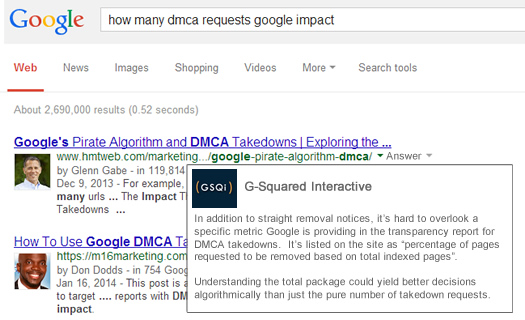
If this type of answer card rolls out, and the hover card provides enough of the answer, users will never hit your site. So, if you are hoping that users visit your site to find the answer, and then take some other action on your website, good luck. You better start thinking of another way to get that to happen.
2. How-Tos or Tutorial Segments
If someone searches for how to perform a certain task, and that task is limited in steps, then maybe that information could show up in the search results via a “Tutorial Card”. Or maybe someone is searching for a specific step in a tutorial. Google could provide just that step in a hover card directly in the SERPs.
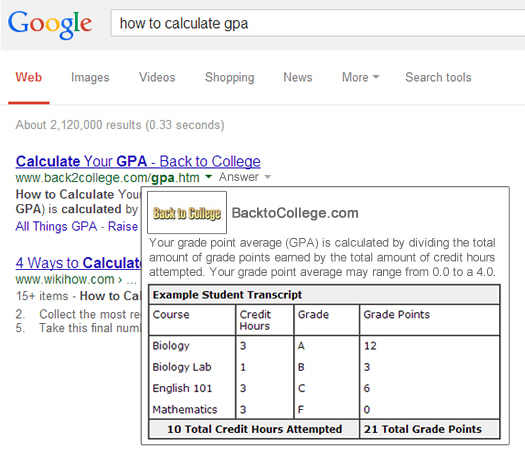
3. Product or Service Information
If someone is interested in a certain product category or service, then maybe that information is pulled directly from sites in that niche. For example, if someone searches for “IT consulting” or “computer science” or “4K television”, Google could provide that information directly in the SERPs via a “Product or Service Card”. For example:
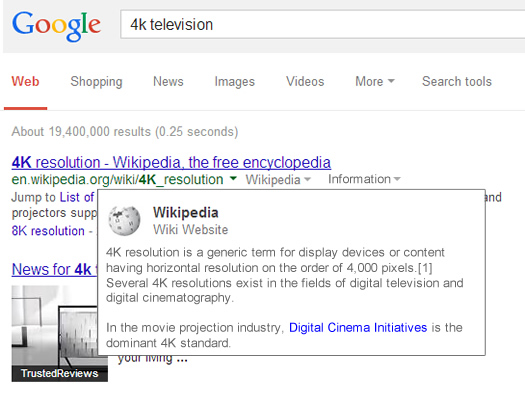
4. Ecommerce – Fighting Amazon via the “Ecommerce Card”
Information is great, but let’s talk about ecommerce. Google and Amazon battle heavily in the ecommerce space. Sure, Google doesn’t sell anything directly, but they make a boatload of money via paid search. And product listing ads (PLAs) are at the heart of that growth right now. On the flipside, many people go directly to Amazon to search for products. That’s the result of a huge inventory, a boatload of review data, and Prime membership (with free, two-day shipping).
But, what if Google decided to provide one-click ecommerce functionality directly in the SERPs? This could be handled by connecting your Google profile to Google Wallet and buying products directly in the SERPs via the “Ecommerce Card”. This would be amazing for people that already know which product they want to buy. It could look like this:
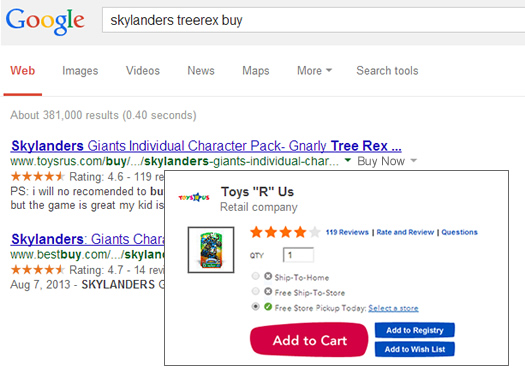
And yes, this would be like AdWords on steroids since Google could generate revenue via the organic listings by earning a percentage of the sale. Holy cow. :) More about the ecommerce impact later in this post.
5. Reviews
Going even further with our ecommerce example, if someone searched for reviews of a product or service, Google could surface that information and provide it directly in the “Review Card”. For some people, the review snippet below would be enough. And that could drastically impact the downstream traffic to pcmag.com.
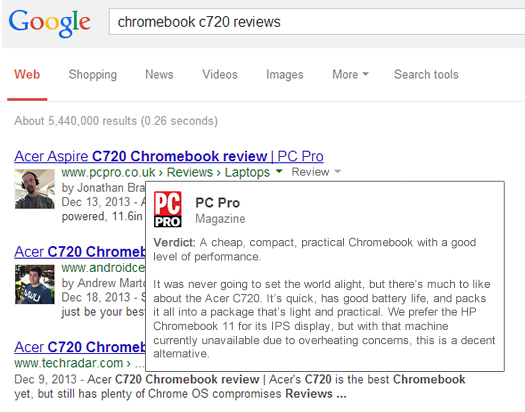
6. Downloads
Along the same lines, what if you were looking to download content via pdfs (or other formats)? Imagine Google provided this download functionality via a “Download Card” directly in the search results. Google could scan each file for malware and tee it up for users to download. And if you want to charge for that file, then you can combine the “Ecommerce Card” with the “Download Card”. That would be a smart combination for sure.
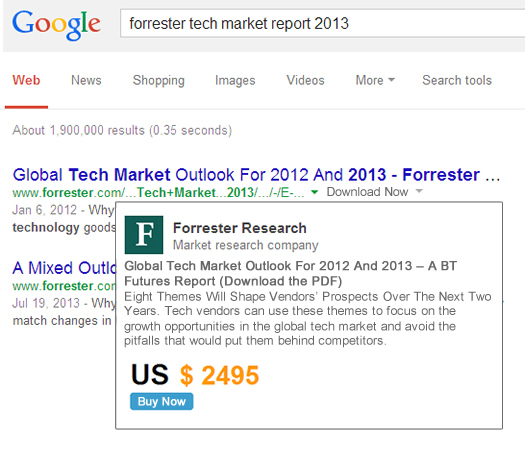
7. Sign-ups/Registration
Looking to sign up for a webinar, join an email list, or confirm you’ll be attending an event? Registration functionality could also be provided directly in the search results. Actually, Google has already been testing functionality for joining email lists in AdWords (via ads in the search results). This could easily be included in a “Registration Card” directly in the organic search results.

I can keep going here… but I think you get the picture. And these hover cards don’t have to be limited to Knowledge Graph data. If Google can verify certain entities, then it can feel comfortable providing more information to users directly in the search results. That data could be answers, information, coupon codes, medical information, pricing, reviews, downloads, list signups, ecommerce functionality, and more.
What Happens if this Rolls Out?
Website owners will riot in the streets. :) Ok, maybe not literally, but this could cause serious problems for many business owners.
Publishers with an Ad-Driven Model
Let’s start with websites earning advertising revenue based on traffic. Well, if a site is charging a CPM (or cost per thousand impressions), and 40% of its traffic goes away, their revenue will take a huge hit. And as their traffic numbers plummet, so will their ability to sell advertising on the site. Publishers will once again need to figure out other ways to monetize, which is no easy feat.
Ecommerce Retailers
Next on the list are ecommerce retailers. The once pure, ROI-driven organic results will now be asking for a commission. If Google does roll out the ability to buy directly from the search results via one-click “ecommerce cards”, then it will surely want a cut of the sale. Remember, advertising comprises a huge percentage of Google’s revenue and product listing ads are doing extremely well for them (via AdWords). But having the ability to sell via the much larger set of organic listings could be huge for Google.
Blogs and Resources
For those writing great content on blogs and resource websites, then the possibility of having that content surfaced in “answer cards” could be a big problem (although not as big of a problem as large publishers and ecommerce retailers). The real downside here would be users gaining answers based on your hard work, without needing to visit your site.
And if they don’t visit your site, they can’t find out more about you, they can’t subscribe to your feed, find your social accounts, or contact you. I’m sure some users will decide to visit the site, but a certain percentage surely won’t. This could lead to a drop in awareness, which could impact multiple channels for content owners. i.e. less subscribers, twitter followers, facebook fans, etc. And of course, this could impact leads and new business for the organizations publishing content.
Hover Card Extensions – A Note About Ads
It’s hard to write about Google without bringing up advertising. Again, advertising drives ~96% of Google’s revenues, so these new hover cards would probably have some type of advertising component. I already mentioned the revenue that ecommerce cards could drive (via a percentage of the sale), but Google could absolutely add sponsored information to hover cards.
For example, imagine having the ability to promote certain pages on your site (to increase click through), provide the ability to subscribe to a feed, follow you on Google+, etc. right from the various hover cards. This type of ad extension could easily be included in the AdWords platform. And if that happens, Google could expand AdWords-like functionality to the organic listings. As long as it’s clearly labeled, and it’s actually helpful to users, then it’s a huge win-win for Google. Users get what they are looking for, and Google just added a massive new source of revenue.
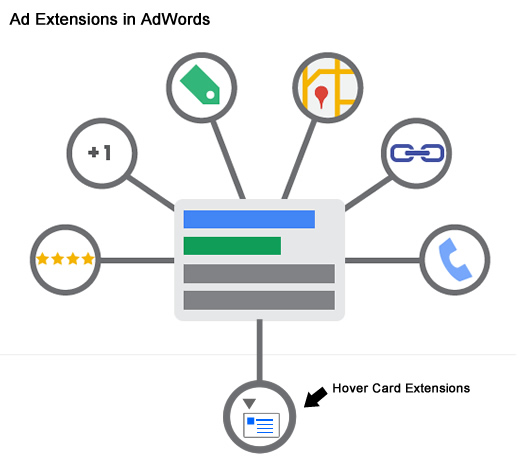
Summary – Hover Cards and the All-Powerful SERP
The addition of “info cards” in the search results caught serious attention last week across the industry. But is this just the beginning? Is it merely a test to see how users react to providing more information directly in the search results per listing? And if it works well, it’s hard to say how much information and functionality Google could provide in the SERPs.
Time will tell how much of what I listed above becomes a reality. Until then, I recommend continuing to diversify your digital efforts. If not, you run the risk of transforming from a website with a lot of traffic into a hover card sitting in the search results. And there’s not much room to play with there.
GG

Thanks for this extremely thorough article! I hadn’t thought of a lot of these options. One other thing I have seen is the ability to sign up for newsletters right on Google (can’t recall at the moment whether this was just on an AdWords ad or in organic results, though).
Google is definitely walking a thin line here, because their business model depends on being able to crawl and link to high quality content. If publishers ask Google not crawl their websites, and people can’t find what they want on Google, then people will stop using Google, and Google will lose a TON of ad revenue from those searchers.
But, as Twitter and a few newspapers have found out, Google is too big for any single company to dictate terms to. It would take a widespread movement, but that wouldn’t happen unless Google tried a few of the tactics you are suggesting here.
Again, thanks for putting all of this together–you have some really interesting ideas about future features that Google might roll out.
Thanks for your comment Jacob. There are so many possibilities with regard to hover cards. I had a number of other mockups ready, but had to keep the post manageable! :)
And you’re absolutely right. Google would be risking a lot if it hurt the user experience or if many content owners rebelled. That’s why I think this very well could be a test to see how users react to the new “info card”. If all goes well, I expect to see additional types of cards roll out. And if that goes well, then Google could absolutely try to monetize those cards. Enter the “ecommerce card”.
Needless to say, this should be interesting to follow! Thanks again.